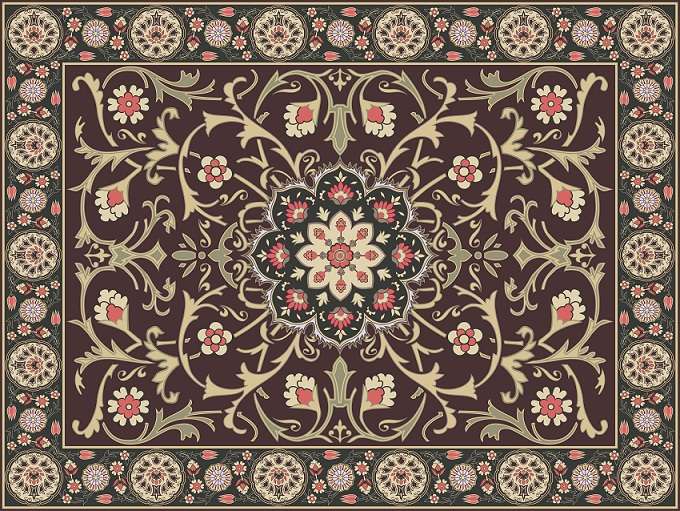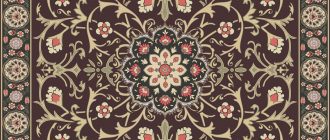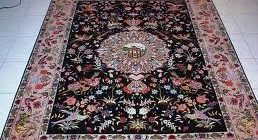Want to buy a Persian or Orienal Rug? Read on…get invaluable insight into the origins, design, materials and craft behind Persian and Oriental Rugs.
This is always a good place to start if one is considering a purchase as just this information alone will give one clarification and insight into what one is seeking. As the countries in the East have always been considered the Orient, a hand woven rug, made from wool, silk or cotton, from this part of the world is the genuine article. A little further delineation could be made if one also added in Western Europe, Northern Africa and Russia. I have seen beautiful handmade rugs from Romania, Uzbekistan and Egypt as well as the Caucasus region between the Black Sea and the Caspian Sea above Iran. The most famous rug weaving countries are Iran, Afghanistan, China, Pakistan, India and Turkey. This is a tradition that dates back thousands of years.
The oldest complete rug found in recent times was discovered in 1949 in a burial site of a Prince in the Pazarik Valley of the Altai Mountains in Siberia. It was frozen in permafrost for over 2500 years! The Pazyrk Carpet is permanently on display at the Hermitage Museum in St. Petersburg. You will find it depicted in the front of almost any rug book in living color. The rug scholars are still arguing as to where it was woven but the exact same weaving techniques are still in use today.
Oriental rugs are not made in the Unites States although we do produce many machine made copies. These would be classified as “Oriental design” rugs.
An average 9 x 12 hand woven rug takes a minimum of 3000 hours of weaving, to say nothing of the time spent on the design, dye preparation, spinning of the wool and the setting up of the loom.
A Persian rug is an Oriental rug but specifically woven in the country of Iran or if an antique (100 years old or more) woven in the former Persian Empire.
All Persian rugs ARE Oriental rugs but not all Oriental rugs are Persian rugs. Hopefully, that makes sense. Probably the reason for this classification is the fact that there is a great history of carpets in Persia, and the Persian weavers of the past were always leaders in design and quality. Proof of this can be found in any major museum in the world and is evidenced most thoroughly by the fact that the majority of designs even today, were originated by Persian weavers. Regions in Persia famous for their carpet weaving techniques include Isfahan, Tabriz and Qum.
Lets talk about basics. All Oriental rugs are woven on a loom by hand. If made in a small village the loom is usually constructed of wood and not perfectly straight but if made in a professional workshop the loom would most likely be metal and more exactly designed.
The loom is strung with vertical threads, which would be the starting point of any rug. These threads are called warps and can be of cotton, wool or silk. Tying loops around a pair of the warps creates the design of the rug. Each knot is tied and individually cut by hand. Modern factory rugs are produced on machines, however, the best quality rugs today are still hand-knotted carpets. One by one, variously colored strands of wool are used to create the design, one row at a time. After one row of knots have been completed, the weft is then inserted between the just completed row and the next one to be done. The wefts function to secure the knots in place and hold the rug together. Some weavers insert only one row of wefts between the rows of knots, others 2, 3, 4 and more.
Most weavers are taught to weave at an early age by a family member and the choice of how many wefts or what type of knot to tie is influenced mainly by heritage and location of the weavers. Although many of the former nomadic (pastoral) weavers now reside in villages their rugs are more often than not a reflection of patterns woven for many generations in their area, each design motif being committed to memory.
In the professional rug workshops the choice of design styles is normally dictated by the demands of the market, either overseas or locally. The warps and wefts are nearly always cotton or silk and the knot count is usually higher than that of village production. In rug workshops the weaving is carefully supervised by a master weaver who is responsible for every loom under his watchful eye. In these workshops the weavers are following an exact design drawn out on graph paper with all color choices predetermined. Tribal or village rugs are often woven in the home with many of the design elements committed to memory. The opportunity for creativity in this arena is much greater. Tribal rugs often are woven on a wool or cotton foundation. The “foundation” being another term for the warps and the wefts. There are of course exceptions to these general rules but basically these concepts hold true.
Prior to the mid 19th century, many of the weaver’s color choices were dictated by the availability of certain plants in their region or what could be obtained by trade. Before the seminal year of 1860, when chemicle based dyes first appeared on the scene, these plant based dyes were all that were available. These dyes are called vegetable dyes and have a distinct look about them. They age beautifully, work harmoniously together and the indigo dye, which creates all the ranges of blue, even preserves the wool. Usually with vegetable dyes one will see a slight or not so slight (depending on the skill of the dyer) variation in the color itself.
Also affecting this is the consideration of the wool being used. Handspun wool, being less perfectly spun will accept the colors of the dyes at different depths of the same shade and will show more variation in color than machine spun wool. Deeply saturated wool will also show less color variation which will only appear after the rug begins to age. This variation of color is termed “abrash” and adds a certain artistic quality and charm if not too pronounced.
More recently, new production using vegetable dyes and hand-spun wool has begun to appear in various areas. Started in Turkey in the 1980′s by a government sponsored program, Iran quickly followed and now there are a number or areas where these great dyes, excellent quality hand-spun wool and traditional designs are being used to create new rugs or more precisely, new works of art!
These rugs could easily be the “antiques” of tomorrow as the weavers creativity and skill is beautifully brought to fruition.
Additionally, there is another weaving technique, which is similar to a Navajo rug called a kelim. This rug is virtually all warps and wefts as there is no pile. This also is an Oriental rug but not as time consuming to weave. The patterns on kelims are normally geometric based designs using large areas of color. These rugs work quite well in contemporary interiors and are often used as wall hangings. Many are quite unique and beautiful although not as hard wearing as a knotted rug. In the past most of these kelims were woven for the weaver’s own use and have only recently become more common in the marketplace.
What is important in evaluating an Oriental Rug? After my many hundreds of hours spent purchasing rugs for my retail business I have come up with the following basics. One of the most important factors in a rug are the colors used and their combinations. Following this would be the actual design elements and how they are put together. Are they pleasing to the eye? Does the rug improve as one looks at it? Is there a sense of balance and depth?
Another important factor is the quality of the wool. What one wants to avoid is “dead wool” taken off an already butchered sheep with a caustic lye type substance. This wool is very dry to the touch, has a dull cast and very inexpensive for the weavers to purchase. Rugs woven with this type of wool do not wear well and are often sold for next to nothing which is exactly what they are worth. A rug woven with excellent wool can easily survive 50 years or more with very little wear if cared for properly.
Good quality wool will actually improve the more it is walked on and will developed an antique patina or sheen that is highly sought after by rug collectors. The moral of the story is to touch the wool, rub the palm of your hand across the face of the rugs. Compare it to another rug. It should not feel overly dry or stiff. Pick the rug up by the edge and see how much it weighs! A hard wearing rug will have some “body” to it. This of course, would not apply to silk as the weight of a silk rug is much lighter. Silk will feel cold to the touch and will have a distinctive shine! Examine the rug carefully by walking around it and viewing it from every possible angle.
Glossy wool often reflects light and sometimes on rugs woven with handspun wool you will have a dark and a light side. If the rug is old, one would look for any signs of moth damage where the pile has been eaten away. With moth eggs on the backside of the rug one will see little white lines. This is not good as the wool on the back may have been eaten so that when one vacuums the front of the rug, the wool comes out! If the rug is new, moth damage would be most unusual and is not a concern.
On older rugs one would also look for signs of repairs, such as a patch sewn in to replace a worn area or holes. Also, inspect the rug in the best possible light to ensure the pile is full as some lazy restorers just paint in the color on worn areas and the rug will have very little life left in it. If the rug is a great deal and these facts have been indicated beforehand, then fine, but if discovered by your own inspection and not indicated, simply pass on the purchase.
These beautiful works of art never completely reveal themselves on first glance but just like the most fascinating and unique person you’ve had the pleasure to meet, a good rug will spark your interest and demand your attention. The longer you gaze upon it, the more it’s beauty and many nuances will be revealed. Always take your time when making a purchase and if possible it is usually best to try the rug in your home for a day or two. This is called taking the rug on approval and any dealer of merit will easily agree to this in home trial period.
Find a retailer that you like, feel confident with and one that offers the types of rugs that you find most pleasing and you’re on your way!
Written by
Penny Krieger is the owner of Paradise Oriental Rugs, Inc., formerly located in Santa Rosa, CA. She now sells Oriental Rugs on an appointment basis in Sonoma and Marin Counties in Northern CA, specializing in unique vegetable dyed rugs from Iran, Afghanistan and Turkey.To see many of her beautiful rugs go to: https://www.paradiseorientalrugs.com





